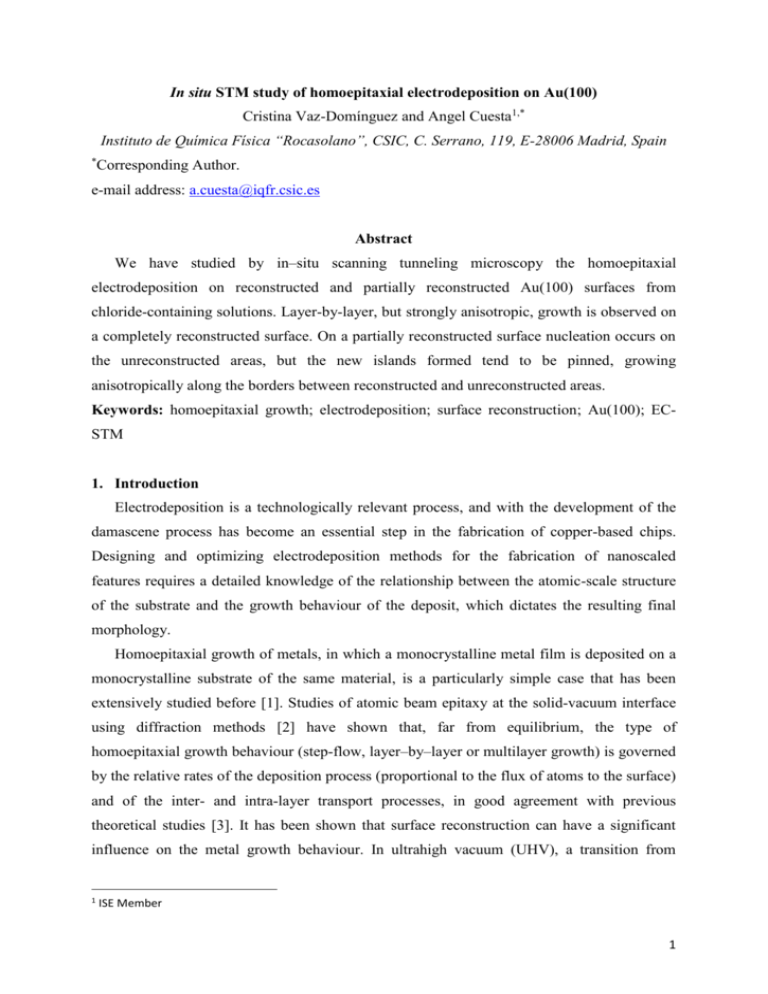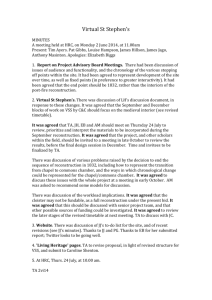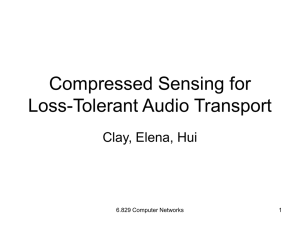In situ STM study of homoepitaxial electrodeposition on Au(100)
advertisement

In situ STM study of homoepitaxial electrodeposition on Au(100) Cristina Vaz-Domínguez and Angel Cuesta1,* Instituto de Química Física “Rocasolano”, CSIC, C. Serrano, 119, E-28006 Madrid, Spain * Corresponding Author. e-mail address: a.cuesta@iqfr.csic.es Abstract We have studied by in–situ scanning tunneling microscopy the homoepitaxial electrodeposition on reconstructed and partially reconstructed Au(100) surfaces from chloride-containing solutions. Layer-by-layer, but strongly anisotropic, growth is observed on a completely reconstructed surface. On a partially reconstructed surface nucleation occurs on the unreconstructed areas, but the new islands formed tend to be pinned, growing anisotropically along the borders between reconstructed and unreconstructed areas. Keywords: homoepitaxial growth; electrodeposition; surface reconstruction; Au(100); ECSTM 1. Introduction Electrodeposition is a technologically relevant process, and with the development of the damascene process has become an essential step in the fabrication of copper-based chips. Designing and optimizing electrodeposition methods for the fabrication of nanoscaled features requires a detailed knowledge of the relationship between the atomic-scale structure of the substrate and the growth behaviour of the deposit, which dictates the resulting final morphology. Homoepitaxial growth of metals, in which a monocrystalline metal film is deposited on a monocrystalline substrate of the same material, is a particularly simple case that has been extensively studied before [1]. Studies of atomic beam epitaxy at the solid-vacuum interface using diffraction methods [2] have shown that, far from equilibrium, the type of homoepitaxial growth behaviour (step-flow, layer–by–layer or multilayer growth) is governed by the relative rates of the deposition process (proportional to the flux of atoms to the surface) and of the inter- and intra-layer transport processes, in good agreement with previous theoretical studies [3]. It has been shown that surface reconstruction can have a significant influence on the metal growth behaviour. In ultrahigh vacuum (UHV), a transition from 1 ISE Member 1 multilayer (3D) to layer-by-layer (2D) growth during homoepitaxial growth on Pt(111) has been attributed to the formation of a high temperature surface reconstruction [4]. Similarly, a transition from 3D to 2D growth was observed during gold electrodeposition on Au(100) when the potential was stepped negatively into the potential regime of the Au(100)-hex reconstruction [5,6]. In the case of Au(111) electrodes, very rough deposits were formed during homoepitaxial growth on the reconstructed surface, due to the formation of Au islands separated by nanogrooves with preferred widths of 6 and 12 nm (i.e., once or twice the distance between the dislocation pairs of the reconstruction) [7], this being a particularly clear example of the impact that the atomic structure may have on the final morphology of even thick deposits. As noted above, homoepitaxial electrodeposition on gold single-crystal electrodes has been studied previously, using Surface X-ray Scattering (SXS) [5,6] and, in the case of Au(111) electrodes, also using in situ electrochemical scanning tunneling microscopy (ECSTM) [7]. SXS can determine lateral distances with a higher precision than STM (which is often affected by thermal, and sometimes mechanical, drift), can interrogate the subsurface region, and allows to avoid the shielding effect of the scanning tip on the scanned area, that can affect the local deposition rate [8,9]. On the other hand, SXS provides structural information averaged over a large area of the surface, while STM provides detailed information on processes occurring locally, that cannot be interrogated using SXS and that can have a deep impact on the final morphology of the deposit [7]. In this article we present the results of an EC-STM study of homoepitaxial electrodeposition on Au(100) that complete and complement those reported previously by Magnussen and co-workers using SXS [5,6]. 2. Experimental The working electrode used was a single crystal disc (10 mm diameter) from MaTeck (Jülich, Germany). Before each experiment, the crystal was annealed in the flame of a Bunsen burner. The STM used was a PicoLE Molecular Imaging with a PicoScan 2100 Controller. Experiments were performed with tungsten tips, etched from a polycrystalline wire in 2 M NaOH and coated with nail polish or polyethylene glue (ethyl-vinylacetate copolymer) from a polyethylene glue gun, in order to reduce the faradaic current at the tip/electrolyte interface. A platinum wire was used as quasi-reference electrode, although the potentials in the text are referred to the Ag/AgCl(KClsat) electrode. All images were measured in 0.1 M HClO4 + 1 mM HCl and recorded in the constant-current mode (IT = 2 nA). The counter electrode was a short gold wire. Due to the small area exposed by the counter electrode to the solution, when 2 the working electrode was polarized at negative potentials, very positive potentials had to be applied to the counter electrode in order to achieve the necessary current density. In the presence of chloride in the solution, this resulted in dissolution of gold from the counter electrode (especially if the solution is saturated with air, as usual in STM experiments, and there is a large current of oxygen reduction on the working electrode). Due to the high overpotential and the low resulting concentration of dissolved gold, diffusion-controlled deposition of gold onto the Au(100) substrate occurs. Typically, the deposition rate was estimated form the STM images to be approximately of 5 x 10-2 ML min-1. Please note that, if a Pt wire is used as counter electrode in the presence of chloride, Pt dissolution would take place, and this could result on Pt deposition on the working electrode, eventually leading to irreversibly damaging the gold single crystal. Raw STM images were treated using WSxM software [10]. 3. Results and Discussion 3.1. Homoepitaxial electrodeposition on reconstructed Au(100) Figure 1 shows a sequence of EC-STM images of the same area (the time interval between the first line of an image and the first line of the next one was 8-10 min) obtained during the electrodeposition of Au on Au(100)-hex. The surface was immersed in the electrolyte under potential control at -0.15 V (well within the stability region of the surface reconstruction) right after flame annealing, and, therefore, the morphology shown in Figure 1 corresponds to the thermally-induced reconstruction, which is significantly different from the electrochemically-induced reconstruction (i.e., that formed upon stepping the potential into the region of the Au(100)-hex reconstruction after having lifted the thermally induced reconstruction at positive enough potentials), especially regarding the long-range order (for a review about reconstruction phenomena at Au(hkl) electrodes see [11]). Clear 2D growth can be observed in Figure 1, although the (n + 1)th layer typically starts growing before the nth layer has been completed. This non-ideal 2D growth is in good agreement with previous in situ SXS observations [5,6], and is actually to be expected, because, independently of the relation between the surface diffusion rate of and the flux of incoming atoms, three layers must always be exposed [12]. Figure 1 reveals another interesting aspect: the anisotropic, elongated shape of the islands nucleating on the Au(100)hex surface. Strong anisotropic layer-by-layer growth has been reported previously under UHV [13,14], and was attributed to strongly anisotropic bonding energies and restricted edge diffusion [13], the latter being in good agreement with the observation of kinked step edges along some of the islands (Figure 2a). A consequence of this anisotropic growth is that gaps 3 between islands running perpendicular to the reconstruction rows are filled faster than those running parallel to them, as can be observed in the image sequence in Figure 1. Nomura and Wang [15] explained the observed rectangular shape of the islands by the existence of a magic island width of 6n + 1 atomic rows and a smooth edge, where n is the number of parallel reconstruction stripes, this being in good agreement with our observation of rectangular islands that always contain an integral number of reconstruction stripes (Figure 2). Similarly, we always observe the corrugated dislocation lines of the reconstructed islands to sit in between the corrugated rows of the reconstructed substrate (Figure 2b), as predicted by Nomura and Wang [15], and, following them, suggest that upon nucleation of a reconstructed island the gold layer underneath must revert to the (1 x 1) square structure. In addition to strongly anisotropic bonding energies and restricted edge diffusion, strongly anisotropic diffusion was also deduced from their experimental results by Günther et al. [13]. Anisotropic diffusion was attributed by Günther et al. [13], and later by Bönig et al. [16], to fast adatom hopping along the reconstruction rows, but Nomura and Wang [15] suggested a more complex, long-range exchange diffusion mechanism involving the cooperative motion of adatoms associated with the release of local stress. Local exchange diffusion had been predicted earlier for unreconstructed Au(100) surfaces by Yu and Scheffler based on DFT calculations [17]. Although we did not perform experiments varying the flux of gold ions to the electrode surface and the substrate temperature, and although, contrary to the UHV experiments by Günther et al. [13], our STM images were recorded under continuous electrodeposition of Au, we did observe a tendency to the nucleation of islands of similar sizes on the Au(100)-hex surface (Figure 3). Even when the islands have started to coalesce and a given layer is about to be completed, uncovered areas of the lower layer often separate strips of the growing layer of similar width (see Figure 1). This is in agreement with the observation of flux- and temperature-dependent island sizes by Günther et al. [13], that could be reproduced in the simulations by Nomura and Wang [15]. 3.2. Homoepitaxial electrodeposition on partly reconstructed Au(100) Further insight into the influence of surface reconstruction on the homoepitaxial growth of Au(100) can be obtained by examining the electrodeposition process on a Au(100) surface partially covered by reconstructed areas. Very recently, we have reported that, during the initial stages of the lifting of the reconstruction on Au(111) electrodes, stable dislocation networks are formed, showing a morphology distinct from both that of the reconstructed and that of the unreconstructed 4 surface [18]. We have not observed the formation of similar structures during the initial stages of the lifting of the reconstruction on Au(100), but, in a narrow potential region, coinciding with the peak signalling the lifting of the reconstruction in the corresponding cyclic voltammogram, we have observed that the electrode surface consists of a mixture of reconstructed and unreconstructed areas, the fraction of the surface covered by each of the structures being apparently only potential-dependent and stable with time. An example of this kind of morphology can be observed in Figure 4, recorded after partially lifting the thermallyinduced reconstruction at 0.10 V. The islands present on the electrode surface in Figure 4 are not (or at least, not exclusively) due to lifting of the reconstruction: they are too many (please note that the reconstruction has been lifted only partially) and, in addition, it is well known that the surface mobility of gold adatoms in chloride-containing solutions is very high [19]. Accordingly, these islands must be, at least in a considerable fraction, due to gold electrodeposition. Two other main observations are evident in Figure 4: (i) all the islands form on the unreconstructed areas; (ii) there is a tendency of the islands to get pinned at the border between reconstructed and unreconstructed areas. When this happens, the islands are elongated along the border, an effect that seems to extend more than one layer upwards. One of the reasons for the observed preference of the new islands to nucleate on the unreconstructed areas must be the faster surface transport on the reconstructed surface, the latter having already been claimed as responsible for the 3D-2D growth transition upon formation of the reconstructed surface [5]. In addition to this, the mechanism for the nucleation and growth of islands on the reconstructed surface must be much more complex than on the unreconstructed areas, because, since reconstruction only affects the topmost layer, once an island has nucleated on a reconstructed area, the reconstruction must be lifted in the layer underneath, with the subsequent ejection of the ca. 25% excess atoms, in a necessarily rather complex collective process [15]. Preferred electrodeposition on the unreconstructed areas is observed even when the reconstruction has been lifted from most of the electrode surface and only few, small reconstructed strips remain (Figure 5). In this case, trenches up to three layers deep and several reconstruction lines wide remain on the surface. This is similar to the nanogrooves observed by Polewska and Magnussen during homoepitaxial growth on reconstructed Au(111) [7], but in our case the grooves were observed only when the reconstruction had been partially lifted, and we have not observed trenches deeper than 3 monolayers or the formation of very rough deposits. Curiously, the tendency of the islands to get pinned at the 5 border between reconstructed and unreconstructed areas observed in Figure 4 is also observed at the upper step edges of the unreconstructed areas surrounding the trenches in Figure 5, an effect which was never observed on a step a completely unreconstructed surface, in which case islands are depleted from the regions close to both ascending and descending step edges [20-22]. The observed preference for island nucleation at the borders between reconstructed and unreconstructed areas might be explained by the “skin deep” mechanism for island growth and the closely related long-range exchange diffusion process proposed by Nomura and Wang [15], in which the adatoms first sink into the reconstructed area, the resulting strain being released by cooperative motion of atoms along the reconstruction rows (yielding an effective faster diffusion along the reconstruction lines) and by atom exchange between the reconstructed area and the unreconstructed layers underneath (provoking the emergence of a new island somewhere else on the surface). According to this mechanism, atoms landing on an isolated reconstructed area would be incorporated into the surface layer and provoke the emergence of an unreconstructed island on the adjacent unreconstructed area. Finally, as can be seen in Figure 6, as soon as the potential is made more positive and the reconstruction is completely lifted, the tendency of the islands to get pinned at the upper edge of the step disappears, and they rapidly adopt their characteristic square shape. 3.3. Homoepitaxial electrodeposition on the electrochemically-induced reconstruction on Au(100) Figure 7 shows the same area of the surface shown in Figure 5 six minutes after stepping the potential to -0.2 V, provoking the formation of the electrochemically-induced reconstruction. Interestingly, despite the fact that the reconstructed surface contains ca. 25% more atoms than the unreconstructed surface, the number, the size, and even the shape of the islands and holes present in Figure 5 remains largely the same in Figure 7. This suggests that most of the extra atoms necessary to build up the newly formed reconstruction rows come from the solution. This is confirmed by the formation of only a reduced number of new, small islands on the unreconstructed areas, while, typically, nearly more than a monolayer of gold is seen to be formed (see, e.g., the sequence in Fig. 1) in the time elapsed between the STM images in Figures 5 and 7. As can be seen more clearly in the STM image in Figure 7b, the tendency of new gold islands to nucleate on the unreconstructed areas is maintained during the formation of the electrochemically-induced surface reconstruction. 4. Conclusions In good agreement with previous work under UHV conditions, we have demonstrated the existence of strong anisotropic effects during homoepitaxial growth on reconstructed Au(100) 6 electrodes. On partially reconstructed Au(100) electrodes nucleation occurs on the unreconstructed surface. However, the presence of adjacent reconstructed areas has a pronounced effect on the resulting surface morphology: elongated unreconstructed islands nucleate along trenches up to three layers deep that contain a reconstructed area several reconstruction lines wide at its bottom. The formation of these islands pinned at the border between reconstructed and unreconstructed areas, but more than one atomic layer above it, probably involves a long-range exchange diffusion mechanism. Finally, when the homoepitaxial growth of Au(100) and the formation of the electrochemically induced reconstruction occur simultaneously, most of the extra atoms necessary to build up the newly formed reconstruction rows come from the solution, and not from the edges of steps or islands. Acknowledgement This work has been funded by the DGI (Ministerio de Ciencia e Innovación) under Project CTQ2009-07017. C. V.-D. acknowledges a JAE-Doc fellowship from CSIC. References [1] H. Brune, Surf. Sci. Rep. 31 (1998) 125-229. [2] M.V. Ramana Murty, T. Curcic, A. Judy, B.H. Cooper, A.R. Woll, J.D. Brock, S. Kycia, R.L. Headrick, Phys. Rev. B 60 (1999) 16956. [3] J.A. Venables, G.D.T. Spiller, M. Hanbucken, Rep. Prog. Phys. 47 (1984) 399. [4] M. Bott, M. Hohage, T. Michely, G. Comsa, Phys. Rev. Lett. 70 (1993) 1489. [5] K. Krug, J. Stettner, O.M. Magnussen, Phys. Rev. Lett. 96 (2006) 246101. [6] O.M. Magnussen, K. Krug, A.H. Ayyad, J. Stettner, Electrochim. Acta 53 (2008) 3449-3458. [7] W. Polewska, O.M. Magnussen, Surf. Sci. 601 (2007) 4657-4661. [8] J. Divisek, B. Steffen, U. Stimming, W. Schmickler, J. Electroanal. Chem. 440 (1997) 169-172. [9] O. Sklyar, T.H. Treutler, N. Vlachopoulos, G. Wittstock, Surf. Sci. 597 (2005) 181195. [10] I. Horcas, R. Fernandez, J.M. Gomez-Rodriguez, J. Colchero, J. Gomez-Herrero, A.M. Baro, Rev. Sci. Instrum. 78 (2007) 013705-8. [11] D.M. Kolb, Prog. Surf. Sci. 51 (1996) 109-173. [12] H. Ibach, Physics of Surfaces and Interfaces, Springer, Berlin, 2006. [13] S. Günther, E. Kopatzki, M.C. Bartelt, J.W. Evans, R.J. Behm, Phys. Rev. Lett. 73 (1994) 553. [14] C. Bombis, H. Ibach, Surf. Sci. 564 (2004) 201-210. [15] M. Nomura, X.-Q. Wang, Phys. Rev. Lett. 81 (1998) 2739. [16] L. Bönig, S. Liu, H. Metiu, Surf. Sci. 365 (1996) 87-95. [17] B.D. Yu, M. Scheffler, Phys. Rev. B 56 (1997) R15569. [18] C. Vaz-Domínguez, A. Aranzábal, A. Cuesta, J. Phys. Chem. Lett. 1 (2010) 20592062. [19] R.J. Nichols, O.M. Magnussen, J. Hotlos, T. Twomey, R.J. Behm, D.M. Kolb, J. Electroanal. Chem. 290 (1990) 21-31. 7 [20] M. Giesen, G. Beltramo, S. Dieluweit, J. Müller, H. Ibach, W. Schmickler, Surf. Sci. 595 (2005) 127-137. [21] E. Pichardo-Pedrero, G.L. Beltramo, M. Giesen, Appl. Phys. A: Mater. Sci. Process. 87 (2007) 461-467. [22] E. Pichardo-Pedrero, M. Giesen, Electrochim. Acta 52 (2007) 5659-5668. Figure 1. Sequence of STM images (350 x 350 nm2) of the same electrode area recorded during homoepitaxial growth on Au(100) at E = -0.15 V. Time interval between images: 10 min. The numbers indicate the successively electrodeposited layers, and the capital letters identify individual growing islands. UT = 0.1 V (tip positive). IT = 2 nA. 8 Figure 2. a) STM image (100 x 100 nm2) showing a reconstructed Au(100) island growing on a reconstructed Au(100) surface (E = 0.2 V), containing an integral number of reconstruction lines, and illustrating the frequent observation of kinked edges. b) Zoom in the area (30 x 30 nm2) indicated by the black square, showing that the corrugated dislocation lines of the reconstructed islands sit in between the corrugated rows of the reconstructed substrate. UT = 0.15 V (tip positive). IT = 2 nA. Figure 3. STM image (E = 0.2 V; 400 x 400 nm2) showing reconstructed Au(100) islands of similar width and length growing on a reconstructed Au(100) surface. UT = 0.15 V (tip positive). IT = 2 nA. 9 Figure 4. STM image (500 x 500) nm2 illustrating the homoepitaxial growth on a partially reconstructed Au(100) electrode at E = 0.1 V. The reconstructed areas have been labelled with an R. UT = 0.05 V (tip negative). IT = 2 nA. Figure 5. STM image of the same area in Figure 4 (left, 500 x 500 nnm2) recorded during homoepitaxial growth on a Au(100) electrode with only a small fraction of the surface reconstructed (E = 0.2 V). The Figure on the right is a profile across the green line in the STM image, illustrating the presence of two grooves 12.4 and 6.4 nm wide (corresponding to 10 and 5 reconstruction rows, respectively; measured distance between reconstruction rows: 1.2 nm). Both grooves show the presence of a growing, unreconstructed island several layers 10 above them pinned at the border between the unreconstructed and the reconstructed region. UT = 0.15 V (tip negative). IT = 2 nA. Figure 6. STM images (100 x 100 nm2, IT = 2 nA) showing the change in the morphology of the epitaxial deposit when the reconstruction is completely lifted. a) E = 0.20 V. Some reconstructed areas are still visible, affecting the shape of the islands growing between them, even when two layers high. UT = 0.25 V (tip negative). b) E = 0.25 V. The reconstruction has been completely lifted and the growing islands adopt the square shape characteristic of unreconstructed Au(100). UT = 0.30 V (tip negative). Figure 7. STM images (E = -0.20 V; UT = 0.15 V (tip positive); IT = 2 nA) of the same area shown in Fig. 5 recorded during homoepitaxial growth on the electrochemically induced reconstruction on Au(100) six minutes after stepping the potential to -0.20 V. a) 500 x 500 nm2. b) Zoom (100 x 100 nm2) on the area indicated in a). 11








